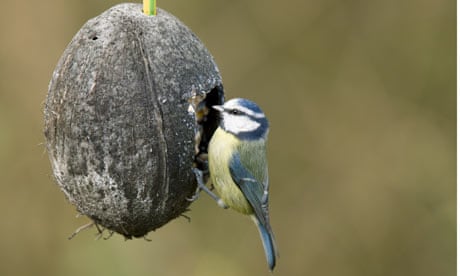It's hard to find a gardener with a bad word to say about wild visitors such as ladybirds, hedgehogs and bees, but birds? They can be a mixed blessing. Every veg grower has a moan about wood pigeons ripping brassicas to shreds and every pond owner mourns fish lost for ever to the sharp beak of a heron. But birds can play a vital role in the garden's ecosystem, as pest controllers of everything from snails to aphids, and as consumers of windfall fruits, they also bring joy to even the dullest plot: I defy anyone to watch a gang of blue tits assailing a peanut feeder or hear a blackbird singing without their spirits lifting.
The Guardian’s journalism is independent. We will earn a commission if you buy something through an affiliate link. Learn more.
Making your garden a haven for birds isn't just about hanging up a bag of peanuts when the weather turns nasty, though. There are lots of ways to give bird populations a boost, from creating new nesting places to introducing plants and trees rich in nuts and berries. Here's how.
Food
The wisdom once was that birds should be fed only in winter, but now the experts advise putting out food all year round: it won't reduce the amount of insects they dispatch, but will encourage more wildlife to your garden. The range of seed mixes, fat balls and peanuts can be bewildering, so keep it simple and buy a mix that includes sunflower seeds, canary seed, hemp and husk-free oats. (If you'd rather not attract pesky wood pigeons, avoid food with lots of wheat, which they love.) A good tube-style feeder will set you back a few pounds from the RSPB , but a more stylish egg-shaped porcelain feeder is easier on the eye, if not the pocket.
Protect your birds from prowling cats by planting something prickly and ground-hugging around the bird table or feeder – Berberis darwinii, say; birds will eat the fruits in autumn, too. Alternatively, Pam Lewis, of the Dorset wildlife garden Sticky Wicket, weaves feeding "cages" out of willow stems to surround her bird feeders and create a safe haven. Clean bird tables and feeders regularly, or you may end up doing more harm than good: a build-up of bacteria from old food can kill birds.
Water
You may have remembered to put out food, but a supply of clean, unfrozen water is just as important, both for drinking and bathing. The RSPB advises using a sloping bath with water 2.5cm-10cm deep, which will allow different species to bathe in comfort. It helps to add a flat stone or two to give birds an easy way in and out. Try to position the bath somewhere prominent where it won't be a chore to clean, and refill regularly. Stone bird baths are the traditional if pricey choice, but birds won't turn up their beaks at a dustbin lid sunk into the soil and filled with water. For something inexpensive but stylish, try the aged ceramic bird bath from Crocus (£14.99). If you want to splash out, the white porcelain Eva Solo bird bath, shaped like a drop of water, would make the perfect centrepiece for a small wildlife garden (£89.95).
Plants
It's no use peppering your lawn or patio with feeders and baths if there is no place for birds to check out the lie of the land (or wait their turn in the queue). Swaths of sterile decking, manicured, empty lawns and bare fences are anathema to the likes of blue tits, thrushes and wrens. Cover in the form of shrubs, trees and climbers is vital. Think mixed hedges of hawthorn, holly, dog rose, goat willow and honeysuckle, ivy-covered arches and pergolas, and house and fence walls draped in shrubs that offer shelter and a fruity treat for the birds – try Pyracantha 'Soleil d'Or', Cotoneaster frigidus 'Cornubia' and rambling roses that will produce lots of rosehips, such as the white, single-flowered Rosa 'Pleine de Grâce'. Dot lawns with specimen trees such as the bird cherry (Prunus padus) or, for small gardens, a crab apple such as Malus 'John Downie'. Sticky Wicket's Pam Lewis recommends Leycesteria formosa (pheasant berry) and the ornamental quince, Chaenomeles speciosa 'Moerloosei', and I love teasel (Dipsacus fullonum) – a bold, architectural plant that doubled the bird count in my garden, attracting crowds of goldfinches who feed on its spiky seed heads in autumn and winter.
Nesting
So you've organised food, water and cover, but what about places to nest and roost? Dozens of species will make use of nestboxes. It's worth putting up new boxes as soon as you can, because birds use the winter to scope out spots to breed come spring. Now's also a good time to take down existing boxes, remove any old nests and rinse the boxes with boiling water. New ones come in every conceivable material and style, from the white gothic nestbox from the Natural Collection (£34.95) to the Ernest Charles's maintenance-free woodcrete box (£21.95). It's not hard to make your own, either – see the National Nest Box Week site for instructions.
Give birds a helping hand with nest-making by putting out extra nesting material for them to grab. Try a terracotta pot full of sheep's wool from the RSPB shop (£9.99) or a wreath of nesting materials from Wiggly Wigglers (£18), or make your own with wool scraps, pet hair, feathers and grasses loosely tied to a framework of twigs or even stuffed in the crooks of trees.
Finally, if you want to help track Britain's changing bird population, join this weekend's RSPB Big Garden Birdwatch.




